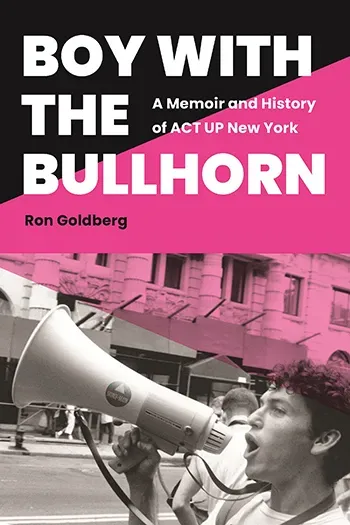BOY WITH THE BULLHORN: A MEMOIR AND HISTORY OF ACT UP NEW YORK
RON GOLDBERG
© 2022 Empire State Editions / Fordham University Press
$36.95
512 pages
Ron Goldberg had read something about ACT UP, the AIDS Coalition to Unleash Power, and he heard they were holding a rally near his workplace. He'd never participated in anything like that before, but whispers were everywhere. He and his friends were "living under a pervasive cloud of dread."
It was 1987. He "was twenty-eight years old... scared, angry, and more than a little freaked out" about AIDS, he says.
Couldn't he at least go down and hold a sign?
That first rally led Goldberg to attend a meeting which, like most, as he came to realize, were raucous and loud and "electric." Because he was "living fully 'out and proud,'" and because he realized that this was an issue worth fighting for, he became even more involved with ACT UP by attending larger rallies and helping with organizing and getting his fellow activists fired up. He observed as women became involved, too. Monday night meetings became, for Goldberg, "the most exciting place in town."
On his years in ACT UP, Goldberg says, "There was hard work, grief, and anger, surely, but there was also great joy." There, he learned how politics mixed with activism, and why ACT UP tangled with the Reagan administration's leaders. He felt more than just a little ownership, as other branches of ACT UP began spreading around the country. He learned from its founding members and he "discovered hidden talents" of his own by helping.
He was, he says, also "a witness. And so, I began to write."
Let's be honest: Boy with the Bullhorn is basically a history book, with a little memoir inside. Accent on the former, not so much on the latter.
Goldberg says in his preface that Larry Kramer, who was one of ACT UP's earliest leaders, encouraged him to pull together a timeline for the organization. This book is the end result of the task. It's very detailed, in sequential order and, as one reads on, quite repetitive, differing basically only in location. It's not exactly a curl-up-by-the-fire read.
Readers, however – and especially older ones who remember the early AIDS crisis – won't be able to stop scanning for Goldberg's memories and tales of being a young man at a time when life was cautiously carefree. The memories – which also act as somewhat of a gut-wrenching collection of death notices – are sweet, but also bittersweet.
This book is nowhere near a vacation kind of book, but if you've got patience, it's worth it. Take your time and you'll get a lot from Boy with the Bullhorn. Rush, though, and it might just go over your head.


